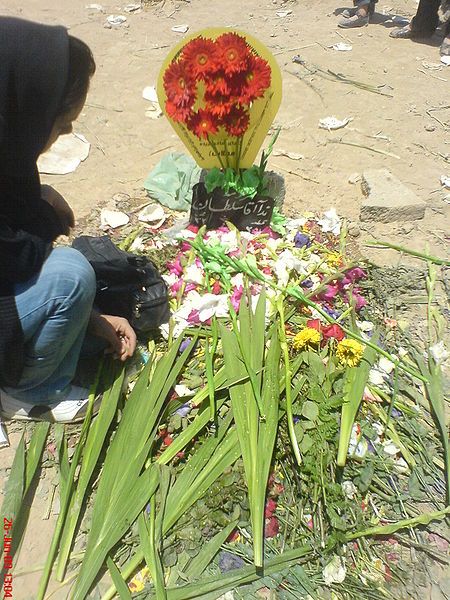
Who was Neda Agha-Soltan?
It seems there isn’t a journalist in the world who hasn’t asked the question. Through her death, her life has captivated the hearts and minds of people both free and otherwise all over the world – yet few for the same reason.
To those who oppose Ahmadenijad, she is a martyr, one of the most recognized and honorable ways for a Muslim to be remembered. To women worldwide and especially in the Middle East, she is a symbol of strength and courage. To Westerners, she is the face of consequence, the casualty of a ruthless, smooth-tongued regime that refuses to let go its hold on a country ready for change or its contempt for countries it feels have stood in its way. To all people, she is the power of imagery breaking through banned media to show the world what Iran’s president prefers we do not see.
Within hours of her death, Neda became all of these things to all of these people, yet she did so having hardly taken part in anything to do with a protest or a rebellion. In fact, all she really did was to stand by and watch.
With the Iranian ban on media coverage of the protests, we’ll probably never know the full story of what happened to Neda. But between eyewitness accounts and two grainy cell phone videos – one before and one after her death – we can deduce enough: she went to the protests with her music teacher, apparently just to watch. There is no evidence that they were more than bystanders; Neda is not described as being particularly politically active, and the video taken of her before her death only shows her and her teacher standing by and looking on. The video shows that the protest she was watching began to intensify with backlash from weapon-wielding forces. Fearing for their safety, Neda and her companion decided to leave. When the next video starts, Neda has already been shot.
The Iranian government has suggested that the shot was fired by a member of a terrorist organization who mistook Neda for someone else, a tactful appeal to the red buttons of a world sensitive to senseless extremism – and a viable cover, since small, one-off terrorist acts are difficult to trace to a person or group. Others speculate that the Basij, Iran’s sanctioned militia force, is responsible for her death (though the government denies the militia’s involvement in anything except riot control). Others are still looking for someone at whom to point the finger. But no matter who pulled the trigger, we at least know that a trigger was pulled.
Mistake or no, Neda died as a result of protests – protests which may never have reached the level of violence they have if they were, at the very least, allowed. What the world has been given a taste of, then, is not graphic imagery splashed across television and computer screens intended to shock the public, exploit the innocent, or satisfy the morbid curiosity of a Western culture almost entirely (and thankfully) unfamiliar with the violent face of death, but instead a truthful scene, the reality of what atrocities come to pass under a true tyrant – a man who makes Americans’ claims of the Bush administration’s dictator-like qualities seem but a children’s story, and a poorly-written one at that.
In this way, Neda has become a universal symbol of oppression that transcends the boundaries of race, gender, religion, and the like. For Americans, this bears with it the shocking realization that while we make a lot of noise (and do little else) about a single scent of tyranny wafting from the White House, there are others out there being killed by governments that care more about being in control of their people than they do about the people themselves.
Perhaps the most captivating thing about Neda, though, isn’t her life or her death. It is not seeing photos of a beautiful young bride-to-be with a gentle smile, or even the horrific image of that same woman’s face covered in her own blood only seconds after the life has left her.
No – what is most remarkable about Neda’s death, what has drawn the attention of the world, is not who Neda was, but who she wasn’t. She wasn’t a political activist or a criminal, and by all accounts thus far, she wasn’t someone who went against the grain much if at all. So how did she end up dead in a Tehran street?
There is no logical answer to this question, and that may be what has instilled both fear and anger into the hearts of both Iranians and Iranian supporters worldwide. If an innocent woman who was not a protester can be shot dead, allegedly by her own government, then what power remains in the hands of anyone outside of Ahmadinejad’s administration? Worse, are there any limits to the power that Ahmadinejad has?
After all, whether it was outright rigging or not, we can say with certainty that something fishy took place in the recent election, and the state response has been to ban protests, ban the media and thereby the outside world, and react to any opposition to such bans with violence and ultimately murder, all the while telling nations like America to stay out of the way.
If we smell the air deeply enough, however, we find that the fear isn’t all on the side of the Iranian protestors. Indeed, much of it comes from Ahmadinejad himself. He knows that the people are not on his side and he seems to think that ruling with an iron fist and a sharp tongue is the best way to beat them into submission. But tyrant after tyrant in history learned that forcing people to support your government will eventually backfire. From Babylon to the English Empire to Nazi Germany, the same lesson is reinforced: the tighter you squeeze, the more will slip through your fingers. Ahmadinejad has been squeezing the Iranian people for years, and Neda’s death, rather than being any sort of catalyst, is probably more representative of the proverbial straw sending the camel to the chiropractor.
Who was Neda Agha-Soltan? Nobody but a woman living her life in the best way she knew how. Perhaps the better question is: Who is Neda now? She is a tragic icon. She is a martyr. She is a sign to the world that all is not well in everyone’s backyard.
But above all these things, the one thing she must be to the world is a warning that along with any loss of freedom comes the loss of human life. As sad as it is that such senselessness is what pushes people to the brink, we may hope that Neda’s unnecessary loss will at least, in time, not be in vain.



